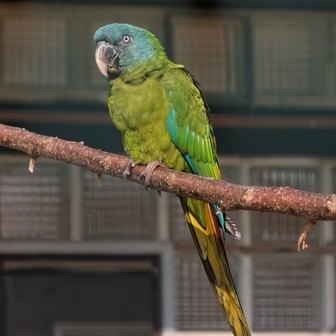Blue-headed Macaw
The Blue-headed Macaw is 41 cm long. It has mainly green plumage with the head, flight feathers and primary coverts blue. The uppertail has a maroon base, a narrow green center and a blue tip. The undertail and underwing are greenish-yellow similar to that of several other small macaws . The bill is pale greyish-horn with a black base . The iris is whitish with a narrow, often barely visible, maroon eye-ring. Unlike most other macaws, the facial skin and lores are dark greyish. The legs are dull pinkish. Juveniles resemble adults, but with the entire bill black, greyer legs, darker iris and the facial skin and lores white.

Original source: Transferred from de.wikipedia; transferred to Commons by User:Snowmanradio using CommonsHelper.(Original text : selbst fotografiert) to Primolius_couloni_-captive-8a.jpg
Author: Primolius_couloni_-captive-8a-3c.jpg: *Primolius_couloni_-captive-8a.jpg: Robert01.
The Blue-headed Macaw is classified as Vulnerable (VU), considered to be facing a high risk of extinction in the wild.
The Blue-headed Macaw or Coulon's Macaw (Primolius couloni) is native to eastern Peru (except in north), north-western Bolivia (mainly in Pando), and far western Brazil (only in Acre). It has a total length of about 41 cm (16 in), making it a member of the group of smaller macaws sometimes known as the Mini-Macaws, which includes any species of macaw with a total length of 50 cm (20 in) or less. As in all macaws, its tail is long and pointed and the bill is large and heavy. More
Choosing a Blue-Headed Macaw Irwin PA = Blue-headed macaws (Ara couloni) are a blue-gray color. The beak is pale. The facial skin in grey and the eyes are bright yellow with red rings around the iris. The tail is long and tapered and is blue and green. Mini macaws are lively boisterous birds and require generous living space. Blue-headed macaws can live up to 30 to 40 years. More
The blue-headed macaw occurs in eastern Peru, extreme western Brazil, and north-western Bolivia (2) (7). View a distribution map for this species at UNEP World Conservation Monitoring Centre. Habitat - These striking macaws are found on the edge of humid lowland evergreen forest, from lowlands up to 1,550 m (2) (7). More
The average length of a Blue-headed Macaw (from head to tip of the tail) is 16 inches (41 cm). The general plumage is green; except the forehead, crown and sides of the head are blue. The flight feathers and primary coverts are also blue. The edge of the wing is bluish-green. The outer upper wing-coverts are blue with green edging. The underside of the flight feathers and tail are olive-yellow. The tail feathers are blue. The bill is black. The frontal area is whitish. More
Lear macaws and six blue-headed Macaws, which were the basis of his conviction at Newcastle in April, 2000. He claims there are only 150 Lear macaws left in the world. Sissen, 63, had placed a value of over More
Rezultati za: blue-headed macawPrijevodi 1 - 30 of 564 Engleski Engleski Finski Finski blue-headed macaw sinipääara, Primolius couloni blue-and-yellow macaw sinikelta-ara, Ara ararauna blue-throated macaw sinikurkkuara, Ara glaucogularis blue-winged macaw brasilianara, Primolius maracana blue-headed bee-eater sinimehiläissyöjä, Merops muelleri blue-headed coucal sinipääkukaali, Centropus monachus blue-headed fantail More
Beautiful Blue-headed Macaw and great capture !!! This beautiful photo seen in : "World Nature & Wildlife Closeup" Post 1 Comment 3 Posted 23 months ago. ( permalink ) view profile LIBRRIAN Pro User says: Gorgeous, my friend. AWESOME! seen in : "Photographer's Gone Wild" Post 1 Award 3 Posted 23 months ago. More
As several other parrots, the Blue-headed Macaw is known to visit clay-licks. Behavior Little is known about its reproductive behavior in the wild, but a possible nest has been recorded in a bamboo cavity and another in a tree cavity. In captivity, the reproductive cycle appears to be roughly annual with a clutch size of 2-4 being the norm. In the wild it is typically seen in groups of 2-4 individuals, with occasional records of groups up to c. 60 individuals. More
blue-headed macaw in gemstones. Green serpentine feathers sweep toward the powerful wings and tail of blue sodalite. Its beak is carved from shiny obsidian and it stands on a caramel onyx tree trunk. The sculpture is set on a black onyx base, and it represents the artisan's personal plea for wildlife conservation. An artisan story card will be included with your purchase. Your Price: $97. More
Blue-headed Macaws in tree Credit: © Luiz Claudio Marigo | http://www.lcmarigo.com.br/ingles/index.htm photos Photos videoVideo 1 Video 2 eNewsletter SIGNUP FOR EMAIL UPDATES Did You Know?The Blue-headed Macaw is not usually found in flocks, like other parrots; in pairs or family trios. More
Until the middle 1990s, blue-headed macaws were unknown in aviculture. Blue-headed macaws are small green "mini" macaws found in tropical foothill habitats in western Peru, eastern Brazil and northwestern Bolivia. They inhabit partially open forest types including disturbed forests. Common locally, blue-headed macaws are usually found in pairs or small flocks. Appearance and Personality Blue-headed macaws (Ara couloni) are a blue-gray color. The beak is pale. More
The Blue-Headed Macaw is not widely kept as a pet because it is extremely rare. It is on the CITES list as endangered. Blue-Headed Macaws live in Central America, near Peru and Bolivia. Not a whole lot is known about their habits in the wild. They tend live in small groups of two or three. In the wild they are usually only seen in flight. Their dietary preferences in the wild are largely unknown. More

Original source: Original uploader was Robert01 at de.wikipedia (Original text : Robert01)
 <img alt=) Psittaciformes
PsittaciformesFamily : Psittacidae
Genus : Primolius
Species : couloni
Authority : (P. L. Sclater, 1876)
